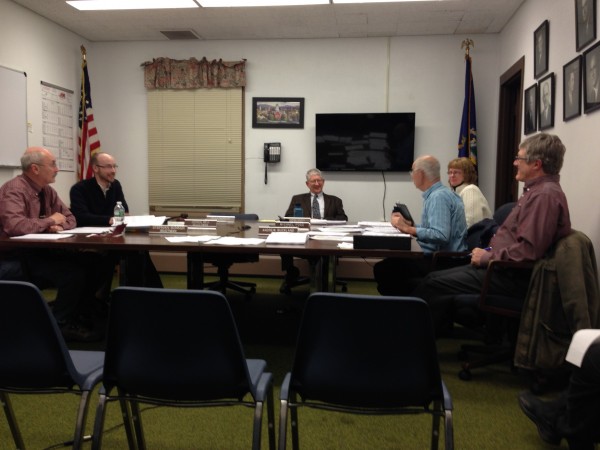
FARMINGTON – At their meeting Tuesday night, selectmen approved sending out a request for engineers to bid on design infrastructure improvements to Front Street, and sections of West Farmington to be paid through tax increment financing revenue .
Also decided, at least for the time being, was to drop the proposal to build a pedestrian bridge across the Sandy River in order to connect downtown with West Farmington.
The work to install new curbing, sidewalks and street lights was recommended by the Downtown TIF Advisory Committee. Also included in their recommendation is to make the entrance to the Whistlestop rail trail and the CN Brown property more attractive and to add an off-street parking area there, add diagonal parking spaces on Bridge Street and parallel spaces on Oakes Street along the VIS Park.
The original plan was to use $100,000 from 2015’s TIF revenue as a 25 percent match requirement for $400,000 in Community Development Block Grant funding for a project total of $500,000 to pay for the infrastructure upgrades.
However, in the interim, town officials discovered that Farmington no longer meets the low- to moderate-income standards for eligibility. Most Franklin County towns, such as Farmington, used to meet the standard 51 percent of low- to moderate-income households, which enabled qualification for CDBG Downtown Revitalization funding when it was based on 2010 census data.
But that changed recently after the U.S. Department of Housing and Urban Development decided the census results weren’t accurate enough and now base eligibility requirements on the American Community Survey. As a result, Farmington’s percentage of low- to moderate-income level dropped from 51.9 percent to 41.77 percent, making it ineligible for federal funding.
Despite the CDBG funding ineligibility at this point, the TIF committee members were all in agreement to get the infrastructure engineering design for the upgrades completed anyway so at least a plan would in place, Selectman Joshua Bell, who also serves on the committee, said earlier.
The committee members also decided not to pursue getting an estimate on updating the cost to build a pedestrian bridge across the Sandy River to connect downtown with West Farmington. A preliminary estimate came in at nearly $5,000 to find out how much the bridge as currently designed might cost. About six years ago, it was estimated to cost $2.6 million to build, thought to be beyond the town’s financial reach.
As an alternative, the committee recommended researching into the idea of a “trail way addition,” a structure which would be built onto Center Bridge so snowmobiles and ATVs don’t have to use the bridge’s one sidewalk. As a first step, the Maine Department of Transportation bridge engineers would need to be consulted on the idea.
Also recommended by the committee was spending $400 for design work on new street banners to be hung on light and utility poles along Main and Front streets and in West Farmington.
Instead, selectmen accepted a donation, with thanks, from John Moore and his employee, Jennifer Hutchinson, who has designed banners for Front Street activities and is willing to do the town’s banner design work at no cost.
Moore, who serves on the TIF advisory committee, said he didn’t want to start off by recommending TIF funding be used for “soft projects,” like design work, as opposed to brick-and-mortar projects. Selectmen also agreed to seek proposals to install electrical outlets for outdoor lighting at the West Farmington traffic island park and the VIS Park in West Farmington.





Have they considered using engineering schools or even the National Guard engineers? Both are always looking for real world training and experience, and perhaps the cost would be more manageable.
I’d be more than happy to donate engineering plans to the town. This will save moore and the lofty task of supporting the soft local professional.